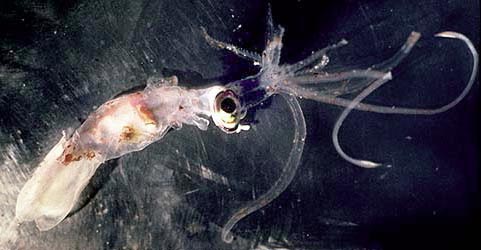Planctoteuthis lippula
Richard E. Young and Clyde F. E. RoperIntroduction
The original description was based two paralarvae, one complete individual and one detached head. Its distinguishing feature is the shape of the club.
Diagnosis
A Planctoteuthis ...
- with a short club bearing a distinct keel.
Characteristics
- Arm suckers (from Chun, 1910 and remnants of holotype):
- Suckers on arms I-III numerous, closely packed in two series.
- Arm IV suckers in a virtual single series.
- Total of 15 suckers on right arm IV, holotype; however, gaps indicate some suckers may have been lost. Over 25 suckers on each arm IV, Hawaiian specimen, 35 mm ML.
- Proxmal 3-5 suckers of arm IV moderate in size; more distal suckers extremely smalll; suckers absent from absent from distal quarter of arm (Hawaiian squid).
 image info
image info Figure. Oral view of proximal region of arm IV of P. lippula, 35 mm ML. Hawaiian waters, stained with methylene blue. Arrows indicate positions of suckers (not all distal suckers can be seen). Photograph by R. Young.
- Tentacular clubs
- Short, broad.
- Club suckers virtually smooth; may have a few rounded knobs (Hawaiian specimen).
- Low, thick protective membranes along both borders.
- Keel present.
 image info
image info Tentacular club of P. lippula. Oblique-oral view. Drawing from Chun (1910).
 image info
image info Tentacular club of P. lippula. Oblique-oral view, 56 mm ML, immature female, 35.2°N, 49.1°W, preserved. Note the terminal pad.
 image info
image info Tentacular club of P. lippula. Oral view of same club. Note that the suckers are larger in the ventral series.
 image info
image info Aboral view of same club. Photographs by R. Young.
 image info
image info Figure. Oblique-oral view of the club of P. lippula, 35 mm ML, Hawaiian waters, preserved. Note the distinct keel and general similarity to the club above from the Atlantic specimen. Photograph by R. Young.
Scanning electron micrographs of the suckers can be seen here.
- Funnel
- Funnel valve absent.
- Locking apparatus broad with deep central groove and with a low, broad antitragus present.
 image info
image info image info
image info Figure. Funnel locking-apparatus of P. lippula. Left - 55 mm ML, 35.2°N, 49.1°W, preserved, unstained. Note the slight indication of a double nature of the antitragus. Right - 35 mm ML, Hawaiian waters, stained with methylene blue. Photographs by R. Young.
- Fins
- Each fin circular in outline.
- Measurements and counts
*Measured from proximal sucker and without straightening club.North Atlantic Hawaiian waters Sex Immature female Mantle length 56 mm 35 mm Fin length 25 mm 14 mm Fin width 37 mm 25 mm Arm I, length 15 mm 9 mm Arm II, length - 14 mm Arm III, length - 18 mm Arm IV, length 40 mm 28 mm Tentacle length 88 mm Club length* 5.7 Arm IV, suckers 19+ / 22+ 25
Comments
Chun's description is based on a 16 mm ML specimen and the head of a second specimen, taken from the same tow, estimated to have a ML of 20 mm. The above description is based on a series of small specimens taken from the central North Pacific and one larger (56 mm ML) squid taken from the North Atlantic. We have not been able to recognize differrences in specimens between oceans that would suggest they belong to separate species. Arm IV sucker counts on the holotype were found in notes we had taken of the holotype many years ago.
Nomenclature
This species was originally described as Doratopsis lippula by Chun (1908) but was transferred to Planktoteuthis by Pfeffer (1912).
Distribution
Type locality - Benguela Current, 11° 28' N., 10° 24' E.
Vertical distribution
In a study off Hawaii, Young (1978) captured 18 Planctoteuthis lippula. Two taken between 200 and 300 m were young squid that had not descended from the shallow, paralarval habitat. Except for a single night capture at 625 m, all other captures were from depths of over 700 m. The larger squid captured, sugest a further ontogenetic descent.
Figure. Vertical distribution chart of P. lippula, Hawaiian waters. Captures were made with both open and opening/closing trawls. Bars - Fishing depth-range of opening/closing trawl. Circle - Modal fishing depth for either trawl. Blue color - Night captures. Yellow color - Day captures. Arrows indicate that the trawl fishing depth extended beyond the limits of the chart. Chart modified from Young (1978).
Geographical distribution
This species is known only from the Atlantic and central Pacific Oceans.
References
Chun, C. 1908. Ueber Cephalopoden der Deutschen Tiefsee-Expedition, Zoologischer Anzeiger, 33: 86-89.
Chun, C. 1910. Die Cephalopoden. Oegopsida. Wissenschaftliche Ergebnisse der Deutschen Tiefsee-Expedition, "Valdivia" 1898-1899, 18: 1-522 + Atlas.
Pfeffer, G. 1912. Die Cephalopoden der Plankton-Expedition. Ergebniss der Plankton-Expedition der Humboldt-Stiftung. 2: 1-815.
Title Illustrations
| Scientific Name | Planctoteuthis lippula |
|---|---|
| Location | Hawaiian waters |
| Specimen Condition | Fresh |
| View | Side |
| Size | 35 mm ML |
| Copyright | © Richard E. Young |
About This Page
Richard E. Young
Dept of Oceanography
University of Hawaii
Honolulu, Hawaii 96822
USA
Page copyright © 1999 Richard E. Young and
Citing this page:
Young, Richard E. and Roper, Clyde F. E. 1999. Planctoteuthis lippula . Version 01 January 1999 (under construction). http://tolweb.org/Planctoteuthis_lippula/19495/1999.01.01 in The Tree of Life Web Project, http://tolweb.org/










